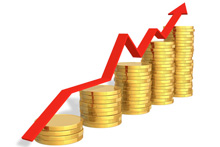Profit from a Forex Investment
Trading in the forex market where currency values keep changing dramatically can be most exciting. Whether you are a novice or experienced trader, a forex investment is a lucrative choice. You end up potentially making money by selling money. Financial experts always recommend diversification when it comes to a portfolio. As clichéd as it may sound, this advice will always hold well, and with numerous opportunities now open in the forex market, there is great potential for the discerning investor. Trading foreign currencies is no longer a prerogative of big investors. The market is now open to the general public and continues to generate increasing interest. However, it is important to learn as much as possible and start small and be fully prepared if you want to succeed as a beginner.
A simple profit equation
 In the forex market the equation is quite simple. The mechanics of the trade is similar to other markets, so if you have experience or knowledge of them, forex investment is something you ought to be able to pick up pretty quickly. The main objective is to exchange one currency with another in anticipation of a price change where the currency you purchase increases in value as compared to the one you sell. For example, the EUR/USD exchange rate is 1.1700 (which means you need $1.17 to purchase 1 Euro) and you purchase 10,000 Euros for a total of (10,000 x 1.17) = $11,700. After a week you exchange the 10,000 Euros back into US dollars at the rate of 1.200 and receive $12,000. You earn a profit of $300.
In the forex market the equation is quite simple. The mechanics of the trade is similar to other markets, so if you have experience or knowledge of them, forex investment is something you ought to be able to pick up pretty quickly. The main objective is to exchange one currency with another in anticipation of a price change where the currency you purchase increases in value as compared to the one you sell. For example, the EUR/USD exchange rate is 1.1700 (which means you need $1.17 to purchase 1 Euro) and you purchase 10,000 Euros for a total of (10,000 x 1.17) = $11,700. After a week you exchange the 10,000 Euros back into US dollars at the rate of 1.200 and receive $12,000. You earn a profit of $300.
Taking long and short positions
In the forex market, currencies are always quoted in pairs. There are 6 major currencies with the most popularly traded being GBP/USD, USD/JPY, EUR/USD, USD/CAD, USD/CHF, and AUD/USD. The main reasons they are quoted in pairs is because you purchase one and sell another simultaneously. For example, in GBP/USD, the British Pound is known as the base currency and the USD is called the quote currency. When trading, you need to determine whether you want to buy or sell. When you buy you purchase the base currency and sell the quote currency. In this case, you predict the base currency is likely to rise in value which you can then sell back at a higher price. This is known as taking a ‘long’ position, which is when you decide to buy. On the other hand, if you sell the base currency and buy the quote currency, where you expect the base currency to fall in value which you can buy back at a lower price, you are said to take a ‘short’ position.
Ask vs. bid price
 In any currency pair you have a ‘bid’ and an ‘ask’ price, where the bid price is lower than the ask price. The bid price is what the broker is willing to purchase the base currency at in exchange for the quote currency. This is the price at which you will sell in the market. On the other hand, the ask price is the value at which your broker will sell the base currency in exchange for the quote currency. For the most part, it is the offer price which is the likely to be the best available price at which you will make a purchase. The difference between the two prices is called a spread, which often plays a vital role in implementing forex strategies. For example, on the EUR/USD if the bid price is 1.4566 and the ask price is 1.4588, and you want to sell EUR then you will need to sell at the bid price of 1.4566. If you want to buy EUR you will make your purchase at 1.4588.
In any currency pair you have a ‘bid’ and an ‘ask’ price, where the bid price is lower than the ask price. The bid price is what the broker is willing to purchase the base currency at in exchange for the quote currency. This is the price at which you will sell in the market. On the other hand, the ask price is the value at which your broker will sell the base currency in exchange for the quote currency. For the most part, it is the offer price which is the likely to be the best available price at which you will make a purchase. The difference between the two prices is called a spread, which often plays a vital role in implementing forex strategies. For example, on the EUR/USD if the bid price is 1.4566 and the ask price is 1.4588, and you want to sell EUR then you will need to sell at the bid price of 1.4566. If you want to buy EUR you will make your purchase at 1.4588.
There are many strategies that can be used to maximize your profit potential and minimize losses. However, it is important to learn as much as you can about forex trading. This allows you to enjoy better returns for your forex investment. With proper risk management, it is possible to choose proper lot sizes and stop loss orders to reduce losses. Make a comprehensive trading plan so that it is easy to reach your goal.





